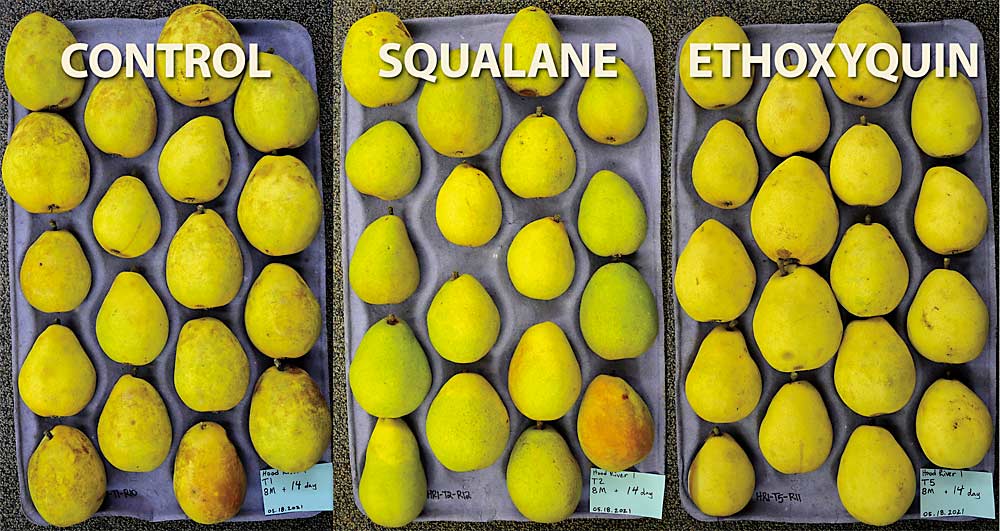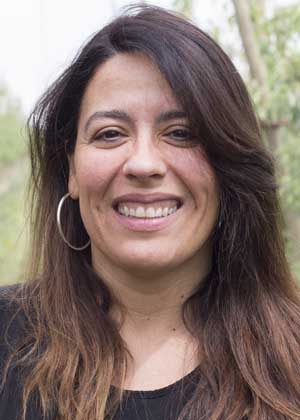
Superficial scald is a significant postharvest disorder of apples and pears, one that’s been in the spotlight since European markets banned residues of diphenylamine (DPA) and ethoxyquin — depriving U.S. producers of their primary tools for preventing the disorder.
More than 10 years later, I believe we have an alternative to offer the pear and apple industries. Squalane, a plant-based oil with antioxidant properties, shows strong anti-scald protection in trials I conducted on Packham’s Triumph and Anjou pears, as well as Granny Smith, Fuji and Red Delicious apples in Chile and in Washington — trials I started when I joined Washington State University in 2019.

Research began at the University of Talca in Chile, but the need to find a replacement for DPA is an industry priority in every pear-exporting region. In Chile, my home country, growers harvest about 300,000 tons of pears every year, primarily for export. Trials focused on Packham’s Triumph, a green-skinned European pear that’s the top variety in South America.
Superficial scald, also known as storage scald, is a physiological disorder characterized by irregular brown patches on the skin, which darken and become sunken as the disorder progresses. It’s a complex disorder affected by variety, growing season conditions, maturity at harvest and chilling postharvest, with the symptoms driven by the oxidation of alpha-farnesene into trienols, which accumulate in the peel in cold storage.
Synthetic antioxidants have long been our best tool to prevent the disorder in susceptible varieties such as Packham’s Triumph and Anjou, along with apples such as Granny Smith and Red Delicious. Bans of these products in Europe, where they can use dynamic controlled-atmosphere techniques and cold-chain management approaches that are not available for regions such as South America that need to ship fruit overseas, led researchers to turn to looking for naturally produced antioxidants that offered a similar effect.
Evidence from Eric Curry, a now-retired postharvest physiologist with the U.S. Department of Agriculture’s Agricultural Research Service in Wenatchee showed in the late 1990s that squalene was an effective anti-scalding agent. But then, as today, it was only produced commercially from shark liver oil. That wasn’t a viable commercial option for many reasons.
Many animals and plants produce squalene, however, so I began to search for natural squalene in a variety of cheap, available raw materials, including pomace from fruit processing, avocado peels and seeds, and salmon byproducts. But none came close to the volume of squalene found in shark liver oil.
Then, for my experiments, I decided to purchase a food-grade squalene produced by suppliers to the cosmetics industry. In a stroke of accidental good fortune, thinking I was ordering squalene, I ordered squalane instead — a slightly different, more stable variation of the compound, derived from olive oil. I didn’t expect it to work, but I found it was effective on apples and pears.
While that original formulation prevented superficial scald, it also caused phytotoxicity, as many oils do. With support from AgroFresh and two grants from the Chilean government, I worked with collaborators to develop a non-phytotoxic food-grade formulation for apples and pears. We accomplished the objectives in all pear and apple cultivars tested, except Granny Smith, which still can show phytotoxicity on some lenticels. At this point, effectiveness on apples had also been found in trials done by Ines Hanrahan at the Washington Tree Fruit Research Commission.
When applied as a drench, we found efficacy levels over 80 percent for Packham’s Triumph pears stored up to 210 days. Superficial scald risk varies from season to season, but in years where control fruit experienced significant amounts of scald, squalane-treated fruit performed very well: Treated fruit stayed greener and firmer compared to both the untreated control and the DPA-treated control.
In Anjou, which we started testing at WSU and at the USDA laboratory in Wenatchee with my collaborator, David Rudell, the results show that it’s also working well as an anti-scalding agent and it keeps the pears greener and firmer for longer in storage. We evaluate superficial scald incidence and severity after six months and eight months in storage, followed by either seven or 14 days at room temperature for the fruit to ripen. Recent data on Anjou show that after eight months in storage and 14 days at room temperature, almost 100 percent of the control fruit showed signs of scald, while less than 10 percent of the squalane-treated fruit did, making it comparable to ethoxyquin, the standard anti-scalding agent here in the Pacific Northwest.
After those promising results, we sought patents for the product and, recently, the intellectual property was licensed by AgroFresh.
For me as a researcher, that’s a success. Now, there’s a good possibility of it going commercial and being available to the warehouses that could use it.
For pears, it’s a formulation that is ready to go. In apples, there’s still some phytotoxicity issues — some minor effects on Granny Smiths. But AgroFresh has expert chemists who can tweak formulas to deal with issues like this and, hopefully, will soon do so. In Red Delicious, we did not observe phytotoxicity in Chile, but local trials need to be done to confirm this.
While it’s up to AgroFresh to handle the commercialization now and find the best ways to deliver the product, it’s still an ongoing area of research for us to understand the mode of action and best timing in pears to apply squalane. In apples, we know that application of an anti-scald compound as close to harvest as possible is key for disorder prevention, but for pears, which are not producing ethylene at harvest, there might be additional timing during storage to apply the product and be effective. We also want to see how squalane performs in combination with other storage regimes, such as dynamic controlled atmosphere.
—by Carolina Torres
Carolina Torres is an associate professor of horticulture and the endowed chair for postharvest systems at Washington State University. She can be reached at ctorres@wsu.edu.






Leave A Comment